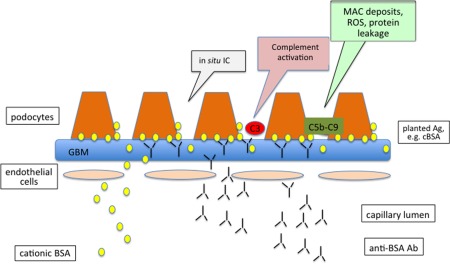Figure 2.

Mechanism of in‐situ subepithelial immune complex formation in early childhood idiopathic membranous nephropathy. Because of its size and charge, modified, the cationic form of bovine serum albumin (BSA) reaches anionic glomerular subepithelial structures and serves as a planted antigen with subsequent formation of immune complexes in situ. The functional impairment represented by proteinuria is the result of formation of the membrane attack complex (C5b‐C9, MAC), which leads to sublethal podocyte injury resulting in the activation of transcription factors encoding for mediators of fibrosis and cytoskeletal podocyte rearrangement. It also increases production of potentially nephritogenic molecules such as reactive oxygen species (ROS), proinflammatory cytokines, proteases and vasoactive molecules.
